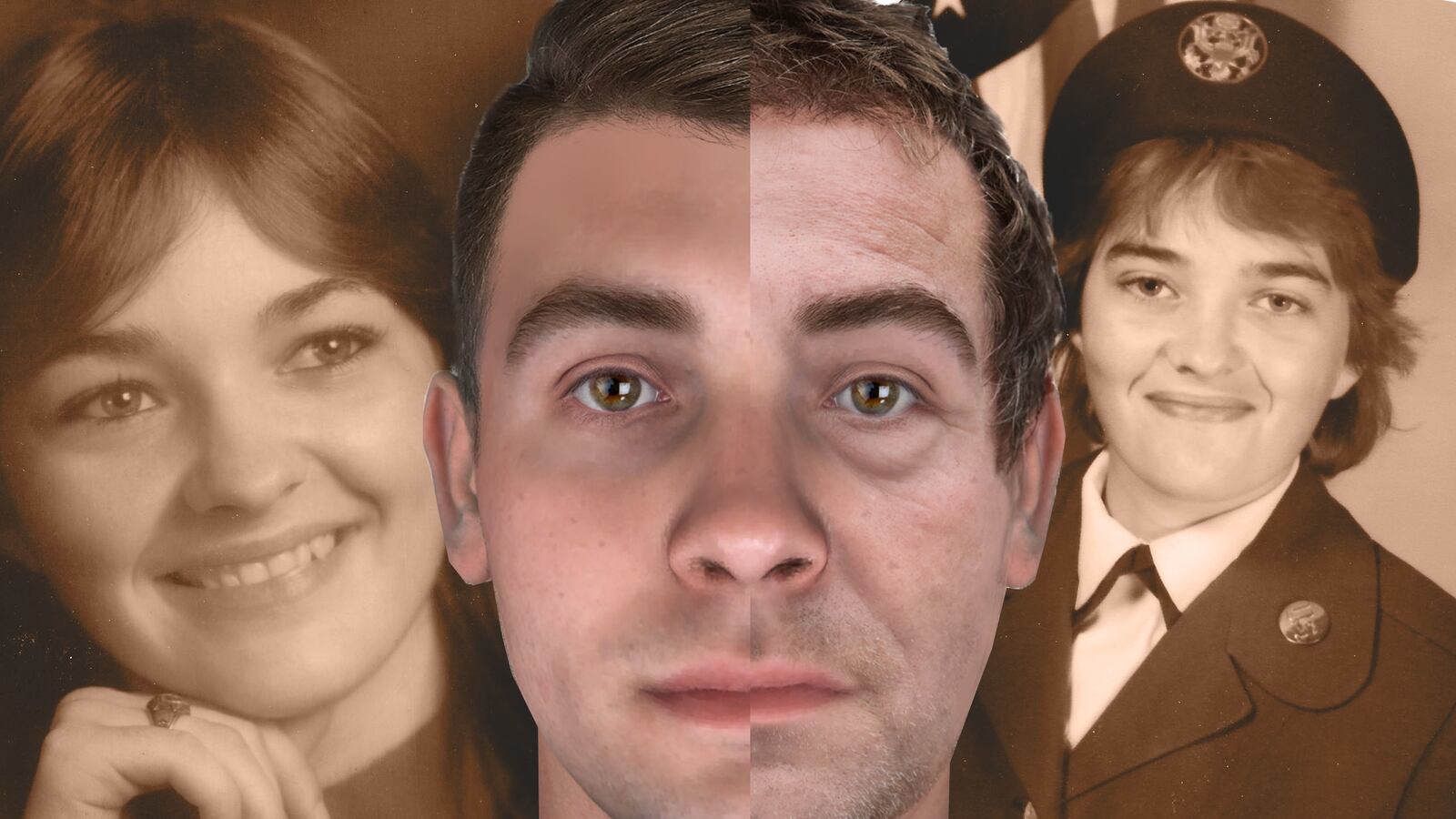DENVER—Paul Krashoc waited 30 years to come face to face with his daughter’s killer, but not like this.
Staring back at him the dining room table were two computer-generated images of the man the U.S. Army suggests murdered Specialist Darlene Krashoc on March 17, 1987, outside Fort Carson, Colorado. One image showed what he might have looked like back then, in his twenties, and the other shows what he might look like today, in his fifties.
“This new spectrum of info, it hit us quickly. This opens up new doors for us,” Krashoc told The Daily Beast. He acknowledges, though, that after 30 years, he and his wife Betty Lou have been “down this road before.”
“Our daughter has been dead longer than she lived,” Betty Lou said. She said she keeps a picture of Darlene in her Bible along with the printout of those two faces.
The Army released the images last month after sending DNA data from 27 pieces of evidence to a private lab called Parabon to undergo a type of analysis called “phenotyping.” Phenotyping uses unidentified DNA to predict appearance and ancestry. In its press release, the Army heralded this new development as “state of the art science.” It’s a statement that has some DNA scientists and law enforcement experts fuming.
“Phenotyping is not state of art. It’s not the state of anything,” says retired Denver homicide detective Jon Priest. He is concerned that phenotyping gives false hope to victims’ families who are desperate for answers.
The new images have given Paul Krashoc new energy. He has always suspected that a fellow soldier killed Darlene, and now the phenotype has him convinced.
“This picture. If you look at the haircut, it indicates military,” he said.
Krashoc’s comment is exactly what worries scientists who have been in the field of forensic DNA for years. They say the haircut on the rendering is only a suggestion to help round out the picture, not science.
“It’s giving the family unrealistic expectations,” says Dr. Richard Spritz, director of Human Medical Genetics and Genomics at the University of Colorado School of Medicine. “Do I think it’s likely having this technology will get them to a perpetrator? No. Because the reliability of this technology has never been subject to critical tests. The likely reliability is low.”
Priest echoed the concern.
“This is one of those things that is not proven, supportable, nor accepted,” Priest said, adding he’s not against trying new technology. “The science may get there someday, but it ain’t there now.”
Ellen Greytak of Parabon Labs said she understands that people are skeptical, but adds that they might change their minds if they see a presentation and realize “how strong our results are.”
Parabon, which unveiled the technology just over two years ago, has never had a dissatisfied client, Greytak says. Parabon’s phenotyping process isn’t meant to produce an exact replica of a person’s face, but rather an image that “strongly resembles” the person the unidentified DNA belongs to.
“It helps narrow down suspects… gives law enforcement the ability to eliminate them,” Greytak explained.
On its website, Parabon gives law enforcement a special offer of a free online demonstration. Also offered are testimonies from various investigation-related entities who swear by the technology, including Jose Morales, a detective with the Costa Mesa, California police department.
“We had a cold case for 20 years. We gave up hope. These kinds of cases, they weigh on us,” Morales tells The Daily Beast. His investigation into the random rape and murder of a photography student was solved when the Parabon rendering, plus fingerprints left at the crime scene, linked the killing to a man who was arrested in Mexico and is awaiting extradition.
Still, Spritz takes issue with how Parabon describes its product as a “Snapshot Forensic DNA Phenotyping System, which accurately predicts genetic ancestry, eye color, hair color, skin color, freckling, and face shape…”
Spritz agrees that DNA can determine eye, hair, and skin color, but he stops short at face shape.
“We do not have the knowledge to predict a face based on DNA,” Spritz said.
Greytak says it costs $3,600 for Parabon to analyze the DNA data and come up with its snapshot. But Greytak admits that out of the 100 cases they’ve been involved with, only one has been resolved in the courts.
“It’s not probable cause, and that’s the real problem with it,” says Priest. “If I find somebody it looks like, I can’t arrest the guy!”
The Colorado Springs police, who have been investigating Krashoc’s murder in tandem with the Army since the beginning, also notes that the pictures are not evidence.
“We need to be careful,” said Lt. Howard Black. “We would never bring someone in just based on a picture.” But he said the renderings have brought people with information out of the woodwork. “They do help. If an individual looks at them, the images can help bring back conversations from 30 years ago.”
The Army is also offering a $10,000 reward to anyone who can help find a murderer who has eluded them through three decades that saw the cold case opened, closed, and re-opened again in 2004 and in 2011 as DNA technology advanced.
Though years of fruitless leads have put a chill on the military whodunnit, the brutality of the murder of the beautiful young soldier stunned the town an hour and a half south of Denver.
Veteran Colorado Springs Gazette editor Tom Roeder says he has never seen anything like it in 20 years of covering the Army at Fort Carson.
“We’ve had murders as a result of domestic abuse, but never anything like this.” Roeder adds, “We see from other cold cases at Fort Carson that the C.I.D. [U.S. Army Criminal Investigation Command] usually closes the door and walks away. When the trail goes cold they shove it in the file… that’s been their tendency. Still, someone knows something about this case.”
Krashoc had been out at an off-base nightclub called Shuffles on the eve of St. Patrick’s Day, 1987, drinking with friends who worked with her in the 73rd Wheeled Maintenance. Her parents say a friend later told them she got mad when she couldn’t get a cigarette from one of them, and put up such a scene about it, they left her there.
Just before dawn police found Krashoc’s body dumped in an alley behind a Korean restaurant. They think the 20-year-old Army specialist’s body was brought there from somewhere else, because of the time it must have taken to torture her. The autopsy report even suggested she may have been thrown out of a moving car. The woman friends had nicknamed “Krash” had been sexually assaulted, beaten, bitten, and, strangled with a coat hanger.
That clue led her parents to believe the killer was a soldier named Jeffrey Newsome, who was stationed at Fort Carson and accused by two women of strangling them with a coat hanger before he was convicted of murder in Alabama.
Newsome has been eliminated as a suspect, according to police though they won’t divulge the reason. Lt. Black did say that there has never been a match with the DNA found on Krashoc’s body through CODIS, a database that compares samples found from crime scenes to the DNA of convicted felons and sometimes, to arrestees. Since Newsome is in prison for life, that means his DNA did not come up as a hit.
Because the Krashocs anticipated that they may have to exhume Darlene’s body for more forensic evidence, they buried her in a civilian cemetery instead of in a military one where it’s much harder to get an exhumation done.
The 30-year stress of never finding Darlene’s killer has been too much for their relationship with people who loved her the most. They say that they no longer speak to their other daughter, Darlene’s sister, Rhonda, and the same goes for Darlene’s best friend who was stationed at Fort Carson and even roomed with her.
Long years of searching with no answers gnaws at everyone involved, and so does a statement Darlene made the last time Betty Lou spoke with her on the phone.
“There’s something going on at Fort Carson,” Darlene told her mom. But the young woman would not reveal anything more.
“I asked her, ‘What the hell’s going on out there?’ and she just said, ‘I can’t tell you right now.’ The weird thing is, just a week before that phone call, Darlene was talking about re-enlisting.”
Betty Lou said she was afraid her daughter was thinking about going AWOL, but instead, says her husband, “A week later, the guy was at the door in uniform to tell us she was dead.”
The Krashocs do not believe that the Army did all that they could have when memories were fresh. They recall that early on during the investigation, they walked into the Office of Command at Fort Carson, and they were turned away.
“They didn’t want publicity,” says Paul, a veteran Army deep sea diver. “We were shaken up, but that’s when we decided to become a pain in everyone’s rear end.”
Through the years, the Krashocs have done their share of amateur sleuthing. Betty Lou has cardboard boxes in their home office filled with newspaper clippings of similar murders which happened all over the world.
“I look them up, call the police in charge, and let them know about Darlene.”
The snapshot DNA sketches and Darlene’s picture will stay in Betty Lou’s Bible. They’ve read the comments on social media about how the new computer images are a long shot. And they know their hopes could be sunk again. Still…
“We could be getting fed a lot of bull,” says Paul. “Obviously we don’t know how this will turn out. But what else can we do?”






